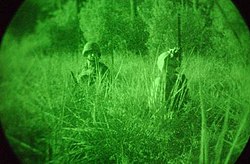Night vision enables organisms and devices to see in low-light conditions through either natural scotopic vision or technological assistance. The human eye has limited night vision capabilities compared to nocturnal animals due to lacking specialized adaptations.
Biological Night Vision Mechanisms
How Eyes Adapt to Darkness
The human eye uses rhodopsin, a specialized protein in rod cells, to detect dim light. Full dark adaptation takes about 45 minutes, though most adaptation occurs within 5 minutes. The pupils can dilate from 2mm to 8mm to let in more light.
Animal Adaptations
Nocturnal mammals possess unique rod cells with inverted nuclei that amplify light sensitivity 8-10 times without losing focus. Many animals have a tapetum lucidum, a reflective layer behind the retina that increases available light – this causes the eyeshine seen in cats and dogs.
Night Vision Technologies
Image Intensification
These devices multiply existing light from stars or moonlight using photomultiplier tubes. The PVS-14 monocular leads NATO forces’ night vision equipment due to its versatility and affordability.
Active Illumination
This method pairs intensification technology with infrared light sources (700-1,000 nm wavelength). While providing high resolution, the infrared emissions can reveal positions during tactical operations.
Thermal Imaging
Thermal cameras detect temperature differences without needing light. They work in complete darkness and can penetrate fog and smoke. However, they cannot see through solid walls or glass.
Applications and Uses
Military and Security
Night vision devices equip military forces for nighttime operations. Enhanced Vision Systems (EVS) help aircraft pilots maintain situational awareness.
Civilian Uses
Automotive night vision systems assist drivers in darkness and poor weather. Security systems employ active infrared for surveillance. The technology continues expanding into commercial and residential applications.
Citations:
https://en.wikipedia.org/wiki/Night_View
Night vision is the ability to see in low-light conditions, either naturally with scotopic vision or through a night-vision device. Night vision requires both sufficient spectral range and sufficient intensity range. Humans have poor night vision compared to many animals such as cats, dogs, foxes and rabbits, in part because the human eye lacks a tapetum lucidum, tissue behind the retina that reflects light back through the retina thus increasing the light available to the photoreceptors.

English
Noun
night vision (uncountable)
- The ability, either naturally, by technology or by superpowers, to see in a low light or even dark environment

